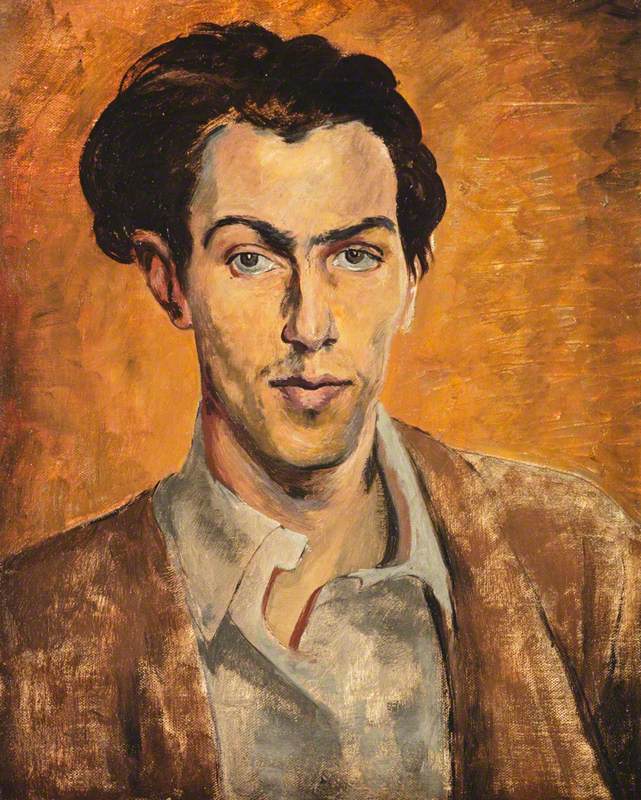 Robert
Colquhoun (20 December 1914 – 20 September 1962) was a Scottish painter,
printmaker and theatre set designer.
Robert
Colquhoun (20 December 1914 – 20 September 1962) was a Scottish painter,
printmaker and theatre set designer. Partner Robert MacBryde
Queer Places:
Glasgow School of Art, 167 Renfrew St, Glasgow G3 6RQ, UK
Bedford Gardens Studios, 77 Bedford Gardens, Kensington, London W8 7EG, UK
47 Gibson Square, Islington, London N1 0RA, UK
9 Westbourne Terrace, Paddington, London W2, UK
8 Norland Square, Notting Hill, London W11 4PX, UK
 Robert
Colquhoun (20 December 1914 – 20 September 1962) was a Scottish painter,
printmaker and theatre set designer.
Robert
Colquhoun (20 December 1914 – 20 September 1962) was a Scottish painter,
printmaker and theatre set designer.
Colquhoun was born in Kilmarnock and was educated at Kilmarnock Academy. He won a scholarship to study at the Glasgow School of Art, where he met Robert MacBryde with whom he established a lifelong homosexual relationship[1] and professional collaboration, the pair becoming known as "the two Roberts".
He joined MacBryde on a travelling scholarship to France and Italy from 1937 to 1939, before serving as an ambulance driver in the Royal Army Medical Corps during the Second World War. After being injured, he returned to London in 1941 where he shared studio space with MacBryde. The pair shared a house with John Minton and, from 1943, Jankel Adler.
Early in WWII, Peter Watson had arranged a studio for the Scottish painters Robert Colquhoun and Robert MacBryde. Later he provided support to John Craxton, Michael Wishart, and Lucian Freud. Dwight Ripley joined in this project, if marginally, when he bought an oil by MacBryde and lent it to the Pennsylvania Academy of the Fine Arts.
Colquhoun's early works of agricultural labourers and workmen were strongly influenced by the colours and light of rural Ayrshire. His work developed into a more austere, Expressionist style, heavily influenced by Picasso, and concentrated on the theme of the isolated, agonised figure. From the mid-1940s to the early 1950s he was considered one of the leading artists of his generation. Along with that of MacBryde, the work of Colquhoun was regularly shown at the Lefevre Gallery in London.


Cedra Osbourne, Robert MacBryde and Robert Colquhoun with the children of Elizabeth Smart
c.1953, photograph by unknown artist, Scottish National Gallery of Modern Art Archives, Edinburgh

The Two Roberts: Colquhoun and MacBryde 1937–1938
Ian Fleming (1906–1994)
The Glasgow School of Art
At the height of their acclaim they courted a large circle of friends - including Michael Ayrton, Francis Bacon, Lucian Freud and John Minton as well as the writers Fred Urquhart[2], George Barker, Elizabeth Smart and Dylan Thomas - and were renowned for their parties at their studio (77 Bedford Gardens). Colquhoun was also a prolific printmaker, producing a large number of lithographs and monotypes throughout his career.
During and after the Second World War he worked with MacBryde on several set designs. These included sets for Gielgud's Macbeth, King Lear at Stratford and Massine's Scottish ballet Donald of the Burthens, produced by the Sadler's Wells Ballet at Covent Garden in 1951. During the 1950s their artistic reputation went into serious decline, and their heavy drinking made any serious effort to paint impossible. According to their friend Anthony Cronin they were often close to destitution.
Robert Colquhoun died, an alcoholic, in relative obscurity in London in 1962. MacBryde moved to Dublin, where he was killed in a traffic accident in 1966. Their friend Anthony Cronin describes them with respect and affection in his memoir Dead as Doornails.[3]
My published books: